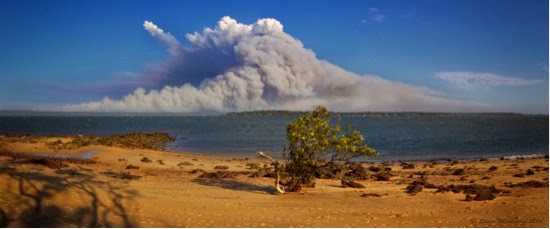Indigenous burning and Stradbroke’s environment
The devastating New Year fires raise serious questions about current fire-management on Straddie. It is hard to believe the Minjerribah people would have tolerated the kind of destructive fires the island now endures, that they would not have used fire as a controlling tool. For this reason those in authority might do well to look to the indigenous community for advice on traditional methods of guarding against uncontrolled fires.
During the nineteenth century when the Minjerribah people still retained a large measure of control over their environment, there is no record of damaging fires. As evidence of their fire-management here are two historical references.
On October 13, 1873, Gustavus Birch who lived at Amity, recorded in his diary that local clansmen had returned with honey 'after having set fire to country.' In an article in the Queenslander in June 1877, a white visitor to Amity described seeing an indigenous man using a firebrand at night to spot-burn the long grass on the foreshore. Presumably he chose night-time because the grass would then be damp from dew or an afternoon shower.
How different the island looked before British settlement we can only guess. Bill Gammage's book The Greatest Estate on Earth provides clues − fire-managed grasslands on the headlands, as is consistent with evidence he documents on Australia's mainland, more grassland created inland as an aid to hunting kangaroos, and on flat foreshores for use as meeting-grounds. Such native grassland, as Gammage has established, needed to be maintained regularly with burnings conducted by men and women skilled in the variables of grass type and season.
Long-time resident of the island, Ellie Durbidge, remembers the headlands above Point Lookout's beaches as being grassed, not forested as they are now. Nineteenth century photos of the Dunwich area reveal it was similarly lawn-like. As the Minjerribah people gradually lost control over their environment, horses unwittingly continued the job of maintaining these parklike expanses. They were, Ellie Durbidge recalls in her book Historic North Stradbroke Island, the island's only lawn-mowers. But when the horses were removed from the island, vegetation began encroaching on what was, in effect, a sophisticated system of fire-breaks.
During the nineteenth century when the Minjerribah people still retained a large measure of control over their environment, there is no record of damaging fires. As evidence of their fire-management here are two historical references.
On October 13, 1873, Gustavus Birch who lived at Amity, recorded in his diary that local clansmen had returned with honey 'after having set fire to country.' In an article in the Queenslander in June 1877, a white visitor to Amity described seeing an indigenous man using a firebrand at night to spot-burn the long grass on the foreshore. Presumably he chose night-time because the grass would then be damp from dew or an afternoon shower.
How different the island looked before British settlement we can only guess. Bill Gammage's book The Greatest Estate on Earth provides clues − fire-managed grasslands on the headlands, as is consistent with evidence he documents on Australia's mainland, more grassland created inland as an aid to hunting kangaroos, and on flat foreshores for use as meeting-grounds. Such native grassland, as Gammage has established, needed to be maintained regularly with burnings conducted by men and women skilled in the variables of grass type and season.
Long-time resident of the island, Ellie Durbidge, remembers the headlands above Point Lookout's beaches as being grassed, not forested as they are now. Nineteenth century photos of the Dunwich area reveal it was similarly lawn-like. As the Minjerribah people gradually lost control over their environment, horses unwittingly continued the job of maintaining these parklike expanses. They were, Ellie Durbidge recalls in her book Historic North Stradbroke Island, the island's only lawn-mowers. But when the horses were removed from the island, vegetation began encroaching on what was, in effect, a sophisticated system of fire-breaks.
This letter to the editor by Julie Kearney (FOSI committee member) was published in the latest issue of SIN.

